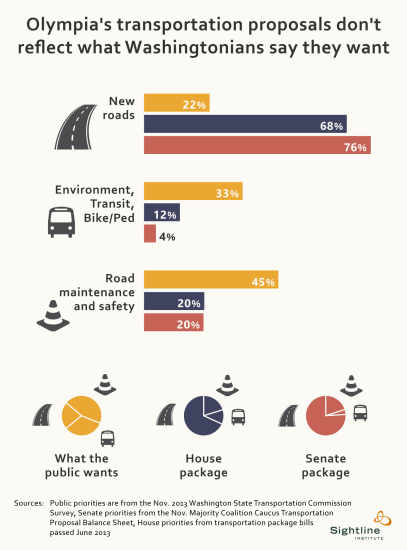Political observers have all but written the obituary for a transportation package in Olympia this year. Deadlocked negotiators could go back to the table in early 2014, or even start afresh in the next legislative session.
Yet the impasse could be a blessing in disguise, since it could give legislators a chance to fix the package’s fatal flaw: that it goes wildly against what Washington residents say they want from a transportation package. Neither of the proposals currently on the table—which focus singlemindedly on expanding highways and skimp on nearly everything else—reflect the balanced set of priorities that the public favors.
 Click on the chart to embiggen.
Click on the chart to embiggen.
To explain how the transportation package got so out of whack, a little history is in order. Last June, the Democratic-controlled Washington House passed a $10 billion transportation package that tilted heavily in favor of new roads, offering relatively little for road maintenance and investments for transit, bicycles, and pedestrians. But a survey released in November by the Washington State Transportation Commission revealed that the public preferred maintaining and preserving existing roads over building new ones, and also strongly supported investments in transit, bicycle and pedestrian projects that help expand the state’s travel options.
Nonetheless, the Republican-led Senate Majority Coalition went in the opposite direction, and dug in its heels on a new $12 billion package that devoted even more money from a 10-cent gas tax increase to building and expanding highways. To make matters worse, the Senate proposal would move money from a toxic waste cleanup fund and also take some tax revenue out of the general fund—moves that, along with the scant funding for transit and other alternatives, turned into sticking points in the negotiations.
Yet despite these differences, the truly remarkable thing is just how closely the two packages resemble one another. Both proposals spend the bulk of new revenue on expanding road capacity: 68 percent in the House package, and 76 percent for the Senate (among the priorities that the state survey covered). Respondents to the Washington State Transportation Commission’s survey, however, would prefer to focus just 22 percent of our resources on expanding road capacity.
This disconnect raises a real risk that voters would overturn the package at the ballot box—perhaps with an ad hoc “Green Tea Party” coalition of anti-tax activists and pro-environment, pro-transit voters. And the risk of pro-transit voters bolting from the package has been increased now that Seattle and King County, which have been held hostage by the state over funding for Metro buses, have come up with Plan B and even a Plan C to save bus service without relying on the state.
So now that legislators have a chance to take a break, they’ll have a chance to reconsider, regroup, and, just maybe, come up with a transportation bill that voters might actually agree with.
Notes: A more detailed description of our methodology can be found at the bottom of this post. To arrive at percentages for the Democratic bill that passed the Washington House of Representatives in June, we followed a similar methodology using line items from a June 2013 breakdown of Rep. Judy Clibborn’s transportation proposal.








Dina Roberts
How much of the Senate package is driven by the tea party wing of the Republican party? Why can’t the Governor propose a package in conjunction with the WSDOT that responds to the will of the people and our collective desire to reduce our GHG emissions here in Washington State. Has anyone ever proposed a rail system that could run in the center of the I-5 corridor, connecting Vancouver BC to Portland OR to start. We need to start thinking bigger than county by county and start planning our infrastructure as a region. I can’t believe the amount of semi truck traffic using our I-5 corridor. We need viable options to get the individual cars off the road and into mass transit. Thanks for your efforts on this issue.